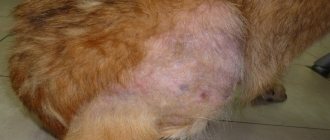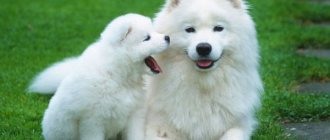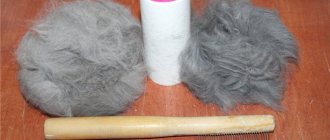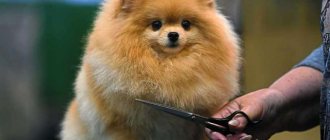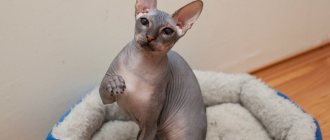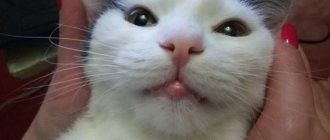09.04.2014
clinic
Twice a year, in autumn and spring, a difficult time comes for owners of furry pets - the molting period. It is especially difficult to cope with the abundance of hair in the house when it comes to animals with long hair of medium or large sizes. On average, an animal sheds from two to six weeks; in rare cases, this process is slightly delayed.
But what to do if your pet begins to lose fur profusely, and the time for planned, seasonal shedding has not yet come? It is known that the condition of the coat signals the internal health of the animal. If your cute furry friend dazzles with the shine of his fur, attracts admiring glances, and makes you want to pet him, then he is in perfect health! And if your cat, rabbit or dog sheds frequently and profusely, itches, the fur does not shine even in the sun, and it feels hard and not silky to the touch, then there is something wrong with the body, you need to show your pet to a veterinarian and get tested.
Unscheduled molt
The cause of unplanned molting can be stress, pregnancy, moving to a new place, surgery, poor nutrition, parasites, lack of vitamins and sunlight, artificial lighting. Animals that live in an apartment can shed all year round. But unscheduled molting can also hide many dangerous diseases of the kidneys, liver, digestive tract and other organs. Another common cause of sudden hair loss can be allergic reactions, fungal diseases, and eczema. The disease can only be diagnosed by a competent veterinarian at a veterinary hospital.
Causes of hair loss
Experts divide the process into natural and pathological; in the first version, it is associated with the spring-autumn change of coat to warmer (in September) or cooler (in February). Planned hair replacement does not cause concern if it takes place within a strictly defined period - 1-3 weeks.
When shedding in dogs occurs spontaneously, without reference to the season (sometimes in winter or summer, all year round), then the animal needs a diagnostic examination. Pathological manifestations may be associated with:
- with hormonal or metabolic imbalance;
- canine dermatological diseases;
- helminths, blood-sucking parasites, lice or lice eaters;
- incorrectly selected diet;
- pathologies of the digestive tract.
Non-standard reactions of the body are provoked by both internal and external root causes:
- year-round hair loss - associated with infrequent walks, high temperature and low indoor humidity;
- temporary - with stressful situations: moving to a new home, surgery, estrus or postpartum month.
Important! My dog sheds a lot, what should I do? Start reviewing existing care products. Incorrectly selected shampoo or too frequent water procedures lead to loss of protective fatty lubricant, dry skin and dandruff in both purebred dogs and mongrels.
Dog fleas and hair loss
Taking care of the fur during the shedding period
Regardless of whether your veterinarian has been able to find the cause of the sudden hair loss, your pet needs care and assistance during the shedding period to comfortably survive this period. What should be done?
- Include vitamins in your animal’s diet, purchase balanced feed;
- you can use special dry conditioners that nourish and improve the structure of the coat;
- Frequent bathing is not recommended;
- Finally, be sure to stock up on combing equipment.
Cat
In the wild, cats shed once a year. When kept at home, a cat's shedding can occur chaotically. If in wild representatives the change of undercoat is associated with climatic conditions, then in a domestic pet other factors can influence shedding:
- unbalanced diet;
- presence of stressful situations;
- avitaminosis;
- leukemia;
- postpartum period;
- excess fat in foods;
- allergy;
- diseases.
Natural shedding lasts 2 weeks; if the process takes longer, it is important to contact a veterinarian. The longest period of molting occurs in 5-8 month old kittens, when they exchange their fluff for real wool. Long-haired breeds require special attention at this time. It is necessary to take care of a nutritious diet enriched with vitamins.
How to comb animals during molting period?
Combs made of hardened steel - it is advisable to choose ones with a nickel coating; they are good at combing out tangles from the undercoat of dogs.
Slickers - remove fur in the most delicate places that can be damaged by a rough metal tool.
Glove brush - combs out and collects dead hair. After four to six days of vigorous brushing, you will be able to remove almost all of the dead fur.
By the way, all this equipment can be replaced with one device - a furminator . It looks like an ordinary comb, shaped like a rake. The “teeth” of the furminator are located in a special way; it does not cut off the undercoat, does not touch living hair, but only catches up to 90% of dead hairs and lifts them up. You should not use the Furminator if there are any wounds, bruises or abrasions, irritations, scratches, or ulcers on your pet’s skin. Combing with a furminator is especially effective after bathing. You need to move the tool gently, so as not to hurt the animal, in the direction of hair growth. No need to use force!
If your dog or cat begins to shed heavily, you need to take immediate action, because animal hair grows slowly, and unscheduled shedding can signal a disease that has been developing in the body for several months. But in order to diagnose whether there is a disease, you must first drive away the worms.
Why do animals shed?
Winter has passed, along with snowfalls and frosts. The long-awaited spring has arrived, the sun is shining - the best time to go to the zoo. But some visitors are dissatisfied and complain: why are snow goats so shaggy, and their fur sticks out in clumps, why has the fox’s fur lost its winter shine and looks somehow dull? Even usually neat wolves still look somewhat unkempt. In fact, everything is very simple: our animals shed. In the spring, they no longer need long, thick and lush hair, without which they would not be able to survive the harsh winter. It's time to replace it with another, lighter, summer one, which is half as long and less common. For example, a squirrel has 1 sq. cm of body surface, instead of 8100 winter hairs, only 4200 summer hairs grow, and instead of 14 thousand hairs, the white hare grows only 7 thousand. The molting of animals has long been of interest to zoologists. Research in recent years has established that, in addition to temperature, it is influenced by light acting on the animal’s body through the endocrine gland - the pituitary gland. For hare molting, the length of daylight hours is the determining factor, while temperature only accelerates or delays this process. The timing of molting in wild animals depends on the geographic latitude of the area. In some mammals and birds, along with molting, the color also changes: the light color is replaced by a darker one. The white winter color of the mountain hare turns gray in summer, and the squirrel changes from gray in spring to red. A similar transformation occurs with ermine, ptarmigan and other species. Here, too, everything is clear: in winter, animals become invisible against the background of snow; in summer, they are more difficult to notice against the background of earth and grass. This is called protective coloration. The molting of animals occurs in a strict sequence and in each species in its own way. For example, in a squirrel, spring molting begins from the head. First of all, bright red summer hair appears on the front end of its muzzle, around the eyes, then on the front and hind legs, and most recently on the sides and back. The entire process of “dressing up” lasts 50–60 days. In foxes, signs of spring molting appear in March. Her fur loses its shine and begins to gradually thin out. The first signs of shedding can be seen on the shoulders, then on the sides, and the back of the fox's body remains covered with winter fur until July. Almost all animals shed. But the inhabitants of a continental climate, characterized by sharp seasonal changes in temperature, the alternation of cold winters and hot summers, shed quickly, but the inhabitants of the tropics and semi-aquatic animals (giraffe, muskrat, nutria, sea otter) - gradually. Most mammals living in temperate latitudes molt twice a year - in spring and autumn, but some animals (seals, marmots, ground squirrels, jerboas) - once. Shedding is a natural process in which old and dead cells and tissues are replaced by newer ones. This means that the fact that our animals shed is an indicator of their health. But if shedding becomes irregular and is accompanied by various painful phenomena (as sometimes happens in domestic cats and dogs), this can really be a cause for concern. Now comes the turn of the second question: why don’t we comb our shedding animals? Well, firstly, this is not entirely true: we still help pets get rid of winter fur. For example, the yak living in the Children's Zoo is regularly brushed. But this won’t work with predators - after all, a zoo is not a circus, and not all animals here allow you to touch them. But they are also not “abandoned to their fate.” Take a closer look: in some enclosures (for example, among musk oxen) you will notice old trees or special structures made of different materials - the so-called “scratchers”. Animals scratch about them regularly and with obvious pleasure. And their winter wool is not wasted - employees then collect it and give it to birds and small animals, who use it to build nests. Such nests can be seen in the Night World. Well, in conclusion, let's look at who is actively molting in the spring in the zoo, who you need to pay special attention to, who is interesting to watch. Molting is easy to notice in guancos, domestic llamas and vicuñas, foxes and hares, gray and red wolves, raccoons and raccoon dogs, musk oxen, snow goats and camels. Maybe you yourself will add someone to this long list? M. Tarkhanova
Photos provided by students of the Art-Zebra studio
Menu for furry pets during molting
During the molting period, it is better to switch your pets to natural food, because the main condition for the growth of a healthy and beautiful coat is a sufficient amount of protein, it gives shine and strength to the coat. Give animals more meat during this period (only lean, lean meat); sometimes you can add chicken liver and hearts to their diet. Once or twice a week, give your shedding animal a piece of boneless sea fish fillet. Fish oil, vitamin B, copper and zinc are also useful for hair growth.
It is important that during this period your pets eat vegetables and grains. They can be mixed into your furry friend's favorite treats.
Return to list of articles
Weasel
Weasel is a predatory mammal similar in appearance to an ermine. Prefers to live alone. Distribution area - all of Europe, most of Asia, Belarus, North Africa.
Weasel can be found in the forest, it can settle on the edge of the river, in the floodplain of the river, a wild representative can be found on the outskirts of meadows and fields. It feeds on mouse-like rodents.
If a weasel has chosen the southern regions to live in, then the color of its coat does not change for the winter; if the weasel has chosen the northern regions, the color of its coat becomes white for the winter.
Arctic hare
As winter approaches, the Arctic hare also changes color. Unlike the hare, he prefers forests with tall thickets of grass, swamps overgrown with sedge and spruce forests. During the warm season, the Arctic hare wears a delicate gray coat.
In the cold season, it turns into a snow-white fluffy ball, and only the tips of the ears remain black - this gives them away as a hare. The Arctic hare does not have a separate mink, so a camouflage coat is extremely important for it. During the day, the animal rests in a snow hole, and at night it gets food: it gnaws the bark of fallen trees.
